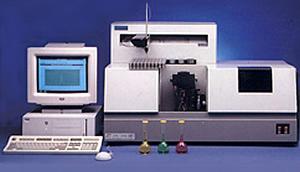|
Instrument Database:
Aurora Biomed - AI 2200 AA/Plasma Emission Spectrometer
| |
|

|
| |
|
| |
|
| Year of introduction |
|
| Status |
historical ( out of sale ) |
| Company |
Aurora Biomed
|
| Categories |
Spectrometer ( Atom. ): AES: CCP-AES
|
|
Features - A transversely heated graphite furnace with 3800 °Ks-1 heating rate
- Aurora Instruments’ patented Capacitively Coupled Plasma Emission Source
- A three dimensional fully programmable autosampler which works universally with all available atomization sources
- MS Windows ME or XP multi-tasking environment with built-in templates and spreadsheets for easy routine analysis
- Fast simple conversion between flame, graphite furnace, plasma furnace emission and vapor generation atomizers
The AI 2200 Atomic Absorption / Plasma Emission Spectrometer features Aurora Instruments' patented Capacitively Coupled Plasma Emission source. This source works on the basis of adding a RF generated plasma to the inside of the transversely heated graphite furnace tube. Here the graphite furnace is used to atomize the sample. The plasma is then automatically initiated inside the tube causing intense emission from analyte atoms. The technology of the AI 2200 Atomic Absorption / Plasma Emission Spectrometer is particularly suited to the analysis of phosphorous, sulphur and other low UV emitting elements.
The GF atomizer features transverse heating of the GF tube and an industry leading 3800K °Ks-1 heating rate. When coupled together it provides isothermal atomization. This device is also a good electrothermal vaporization system for ICP-AES/OES, or ICP-MS. It consists of real temperature sensing display, and programmable carrier gas control. The GF 220 also has the ability to do rapid multi-element determinations of microliter samples. The GF power supply allows for the programming of up to 30 steps to make it a flexible system that suits any need.
Benefits
• Superior performance for P, S and low UV elements
• Allows for analysis of extremely small sample volumes
• Reduced matrix interferences, lower background, enhanced sensitivities
• Improved excitation efficiencies
|
Related links:
|